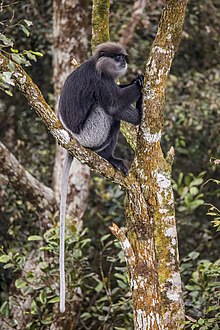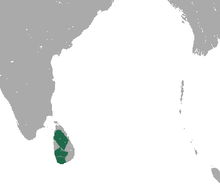
Back Mariol (Trachypithecus vetulus) AVK Белобрад лангур Bulgarian Langur de cara porprada Catalan Semnopithecus vetulus CEB Weißbartlangur German Semnopithecus vetulus Spanish Trachypithecus vetulus Basque Semnopithèque blanchâtre French לנגור סגול-פנים HE Bíborarcú langur Hungarian
| Purple-faced langur | |
|---|---|

| |
| Semnopithecus vetulus vetulus | |
| Scientific classification | |
| Domain: | Eukaryota |
| Kingdom: | Animalia |
| Phylum: | Chordata |
| Class: | Mammalia |
| Order: | Primates |
| Suborder: | Haplorhini |
| Infraorder: | Simiiformes |
| Family: | Cercopithecidae |
| Genus: | Semnopithecus |
| Species: | S. vetulus[1]
|
| Binomial name | |
| Semnopithecus vetulus[1] (Erxleben, 1777)
| |

| |
| Purple-faced langur range | |
| Synonyms | |
|
Trachypithecus vetulus | |
The purple-faced langur (Semnopithecus vetulus),[1] also known as the purple-faced leaf monkey, is a species of Old World monkey that is endemic to Sri Lanka. The animal is a long-tailed arboreal species, identified by a mostly brown appearance, dark face (with paler lower face) and a very shy nature. The species was once highly prevalent, found in suburban Colombo and the "wet zone" villages (areas with high temperatures and high humidity throughout the year, whilst rain deluges occur during the monsoon seasons),[3] but rapid urbanization has led to a significant decrease in the population level of the monkeys.[4] It had traditionally been classified within the genus Trachypithecus but was moved to the genus Semnopithecus based on DNA evidence indicating that is it more closely related to the gray langurs.
In Sinhala, it is known as ශ්රී ලංකා කළු වඳුරා [kʌlu vʌⁿðura] (Sri Lanka black monkey).
- ^ a b Roos, C.; Boonratana, R.; Supriatna, J.; Fellowes, J.R.; Groves, C.P.; Nash, S.D.; Rylands, A.B.; Mittermeier, R.A. (2014). "An updated taxonomy and conservation status review of Asian primates". Asian Primates Journal. 4 (1): 2−38.
- ^ Dittus, W.; Molur, S. & Nekaris, A. (2008). "Trachypithecus vetulus". The IUCN Red List of Threatened Species. 2008: e.T22042A9350371. doi:10.2305/IUCN.UK.2008.RLTS.T22042A9350371.en.
- ^ Post-Disaster Housing Coordination Project (August 2007). "Introduction" (PDF). UN-HABITAT: United Nations Human Settlements Programme – Sri Lanka District Housing Profile (Colombo District). UNICEF. p. 3. Archived from the original (PDF) on 21 February 2016. Retrieved 28 April 2012.
- ^ "Conservation news". Oryx. 42 (4). Cambridge University Press: 481–488. October 14, 2008. doi:10.1017/S0030605308423141. eISSN 1365-3008. ISSN 0030-6053. S2CID 232397905.
© MMXXIII Rich X Search. We shall prevail. All rights reserved. Rich X Search
